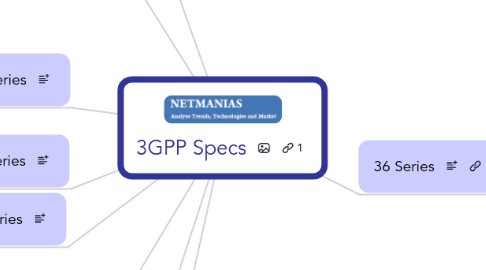
1. 33 Series
1.1. TR 33.106
1.1.1. Lawful Interception Requirements
1.2. TR 33.107
1.2.1. Lawful Interception Architecture and Functions
1.3. TR 33.108
1.3.1. Handover Interface for Lawful Interception
1.4. TS 33.220
1.4.1. GAA; Generic Bootstrapping Architecture
1.5. TS 33.246
1.5.1. Security of MBMS
1.6. TS 33.310
1.6.1. Network Domain Security (NDS); Authentication Framework
1.7. TS 33.320
1.7.1. Security of HNB/HeNB
1.8. TS 33.401
1.8.1. SAE; Security Architecture
1.9. TS 33.402
1.9.1. SAE; Security of Non-3GPP Accesses
1.10. TR 33.816
1.10.1. Feasibility Study on LTE Relay Node Security
2. 29 Series
2.1. TS 29.212
2.1.1. PCC over Gx (Diameter)
2.2. TS 29.214
2.2.1. PCC over Rx (Diameter)
2.3. TS 29.272
2.3.1. S6a: HSS - MME (Diameter)
2.4. TS 29.273
2.4.1. S6b: P-GW - 3GPP AAA (Diameter)
2.5. TS 29.274
2.5.1. GTPv2-C
2.6. TS 29.281
2.6.1. GTPv1-U
2.7. TS 29.061
2.7.1. SGi: Interwoking between the PLMN supporting Packet based Service and PDN
3. 24 Series
3.1. TS 24.229
3.1.1. IP Multimedia Call Control Protocol based on SIP and SDP
3.2. TS 24.301
3.2.1. NAS Protocol
3.3. TS 24.623
3.3.1. XCAP
4. 23 Series
4.1. TS 23.002
4.1.1. Network Architecture
4.2. TS 23.003
4.2.1. Numbering, Addressing and Identification
4.3. TS 23.008
4.3.1. Organization of Subscriber Data
4.4. TS 23.203
4.4.1. PCC Architecture
4.5. TS 23.207
4.5.1. QoS Concept and Architecture
4.6. TS 23.234
4.6.1. 3GPP Sytsems to WLAN Interworking; System Description
4.7. TS 23.246
4.7.1. MBMS; Architecture and Functional Description
4.8. TS 23.261
4.8.1. IP Flow Mobility and Seamless WLAN Offload; Statge 2
4.9. TS 23.327
4.9.1. Mobility between 3GPP-WLAN Interworking and 3GPP Systems
4.10. TS 23.401
4.10.1. Architecture for E-UTRAN Access
4.11. TS 23.402
4.11.1. Architecture for Non-3GPP (Wi-Fi) Access
4.12. TR 23.829
4.12.1. Local IP Access and Selected IP Traffic Offload (LIPA-SIPTO)
4.13. TR 23.830
4.13.1. Architecture Aspects of Home NodeB and Home eNodeB
5. 22 Series
5.1. TS 22.146
5.1.1. MBMS; Stage 1
5.2. TS 22.246
5.2.1. MBMS; User Services; Stage 1
6. 25 Series
6.1. TS 25.446
6.1.1. MBMS Synchronisation Protocol (SYNC)
7. 26 Series
7.1. TS 26.346
7.1.1. MBMS; Protocols and Codecs
8. 32 Series
8.1. Charging Management
8.1.1. TS 32.240
8.1.1.1. Charging Architecture and Principles
8.1.2. TS 32.295
8.1.2.1. Charging Data Record (CDR) Transfer
8.1.3. TS 32.296
8.1.3.1. Online Charging System (OCS): Applications and Interfaces
8.1.4. TS 32.297
8.1.4.1. Charging Data Record (CDR) File Format and Transfer
8.1.5. TS 32.298
8.1.5.1. Charging Data Record (CDR) Parameter Description
8.2. Performance Management
8.3. Configuration Management
9. 36 Series
9.1. TS 36.300
9.1.1. E-UTRA and E-UTRAN: Overall Description
9.2. E-UTRA
9.2.1. RF
9.2.1.1. TS 36.101
9.2.1.1.1. E-UTRA; UE Radio Transmission and Reception (LTE Band)
9.2.1.2. TS 36.104
9.2.1.2.1. E-UTRA; BS Radio Transmission and Reception (LTE Band)
9.2.2. Physical Layer
9.2.2.1. TS 36.201
9.2.2.1.1. E-UTRA; LTE Phy Layer; General Discription
9.2.2.2. TS 36.211
9.2.2.2.1. E-UTRA; Physical Channels and Modulation
9.2.2.3. TS 36.212
9.2.2.3.1. E-UTRA; Multiplexing and Channel Coding
9.2.2.4. TS 36.213
9.2.2.4.1. E-UTRA; Physical Layer Procedures
9.2.2.5. TS 36.214
9.2.2.5.1. E-UTRA; Physical Layer Measurements
9.2.2.6. TS 36.216
9.2.2.6.1. E-UTRA; Physical Layer for Relaying Operation
9.2.3. Layer 2
9.2.3.1. TS 36.321
9.2.3.1.1. E-UTRA; MAC
9.2.3.2. TS 36.322
9.2.3.2.1. E-UTRA; RLC
9.2.3.3. TS 36.323
9.2.3.3.1. E-UTRA; PDCP
9.2.4. RRC
9.2.4.1. TS 36.331
9.2.4.1.1. E-UTRA; RRC
9.3. E-UTRAN
9.3.1. TS 36.401
9.3.1.1. E-UTRAN; Architecture Description
9.3.2. S1
9.3.2.1. TS 36.410
9.3.2.1.1. E-UTRAN; S1 Layer 1 General Aspects and Peinciples
9.3.2.2. TS 36.411
9.3.2.2.1. E-UTRAN; S1 Layer 1
9.3.2.3. TS 36.412
9.3.2.3.1. E-UTRAN; S1 Signaling Transport
9.3.2.4. TS 36.413
9.3.2.4.1. E-UTRAN; S1AP
9.3.2.5. TS 36.414
9.3.2.5.1. E-UTRAN; S1 Data Transport
9.3.3. X2
9.3.3.1. TS 36.420
9.3.3.1.1. E-UTRAN; X2 Layer 1 General Aspects and Peinciples
9.3.3.2. TS 36.421
9.3.3.2.1. E-UTRAN; X2 Layer 1
9.3.3.3. TS 36.422
9.3.3.3.1. E-UTRAN; X2 Signaling Transport
9.3.3.4. TS 36.423
9.3.3.4.1. E-UTRAN; X2AP
9.3.3.5. TS 36.424
9.3.3.5.1. E-UTRAN; X2 Data Transport
9.3.4. MBMS
9.3.4.1. TS 36.440
9.3.4.1.1. E-UTRAN; General Aspects and Principles for Interfaces Supporting MBMS within E-UTRAN
9.3.4.2. TS 36.441
9.3.4.2.1. E-UTRAN; Layer 1 for Supporting MBMS within E-UTRAN
9.3.4.3. TS 36.442
9.3.4.3.1. E-UTRAN; Signalling Transport for Supporting MBMS within E-UTRAN
9.3.4.4. TS 36.443
9.3.4.4.1. E-UTRAN; M2 Application Protocol (M2AP)
9.3.4.5. TS 36.444
9.3.4.5.1. E-UTRAN; M3 Application Protocol (M3AP)
9.3.4.6. TS 36.445
9.3.4.6.1. E-UTRAN; M1 Data Protocol
9.4. LTE Advanced
9.4.1. TR 36.806
9.4.1.1. E-UTRA; Relay Architecture for E-UTRA (LTE-Advanced)
9.4.2. TR 36.808
9.4.2.1. E-UTRA; Carrier Aggregation; BS Radio Transmission and Reception
9.4.3. TR 36.814
9.4.3.1. E-UTRA; Further Advancements for E-UTRA Physical Layer Aspects
9.4.4. TR 36.815
9.4.4.1. Further Advancements for E-UTRA; LTE-Advanced Feasibility Studies in RAN WG4
9.4.5. TR 36.817
9.4.5.1. E-UTRA; Uplink Multiple Antenna Transmission; BS Radio Transmission and Reception
9.4.6. TR 36.819
9.4.6.1. CoMP Operation for LTE Physical Aspects
9.4.7. TR 36.826
9.4.7.1. E-UTRA; Relay Radio Transmissin and Reception
9.4.8. TR 36.871
9.4.8.1. E-UTRA; Downlink MIMO Enhancements
9.4.9. TR 36.902
9.4.9.1. E-UTRAN; Self-Configuring and Self-Optimizing Network (SON) Use Cases and Solutions
9.4.10. TR 36.912
9.4.10.1. Feasibility Study for Further Advancements for E-UTRA (LTE-Advanced)
9.4.11. TR 36.913
9.4.11.1. Requirements for Further Advancements for E-UTRA (LTE-Advanced)
